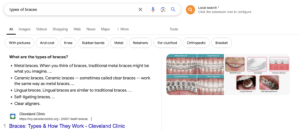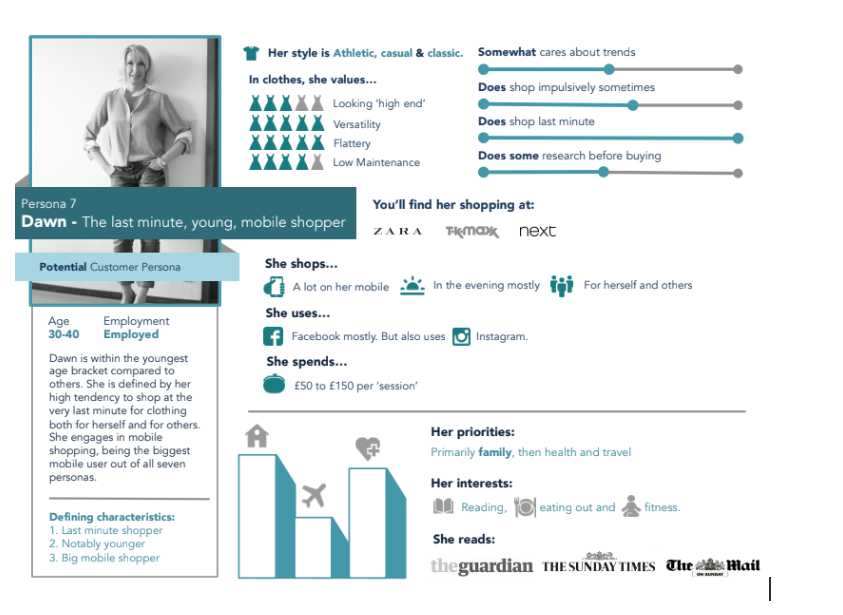
Your content needs to accomplish two goals – persuade your target audience to buy and get traffic
But how do you do it?
If your current traffic doesn’t convert or you don’t know how to get qualified leads to your website, it’s time to change what you do.
The problem with most SEO writers is that they don’t consider their readers when coming up with content ideas. They don’t understand their audience beyond keywords, so they just write about whatever they like.
This is why so many of them fail at ranking high on search engines and converting their visitors into buyers – they are approaching the problem backwards.
Instead of concerning yourself with high rankings, search marketers should concentrate on meeting their customer needs first
Google rewards businesses that meet their customer demands, not businesses that WANT to rank high.
So, it’s not a surprise your current SEO content strategy doesn’t bring the results you want
You need to earn the top position, not wish for it.
The good news is that SEO copywriting could present a huge opportunity for you.
What Is SEO Copywriting Exactly?
SEO copywriting is the art of striking a balance between content that persuades people to buy and content that ranks high on Google.
An SEO copywriter is someone who understands people, knows how to persuade, and makes readers take a specific action.
Without SEO copywriting, you’re going to fail in two ways…
- Your content won’t rank for high-volume quality keywords
- Your content won’t turn visitors into buyers
It takes a lot of effort and talent to create copy that produces results, so at Digivate we make sure that our teams know exactly what they are doing
Whether it’s persuading people to click on your call-to-action buttons, subscribe to your mailing lists or try your products – it’s a copywriter’s responsibility to make people act.
So if you’re concerned that …
- Your pages aren’t showing on Google
- Your pages aren’t converting
- Your content is outdated, and you never really liked it anyway
- Your content was never optimised
… we may be able to help. Our #1 goal is to appeal to your audience so that you can increase your sales. To achieve that we build buyer personas and utilise consumer behaviour data.
Your content must be relevant to both your visitors and search engines like Google.
You’d be surprised at how many businesses or agencies don’t consider the actual readers when building their marketing strategies.
Below are 5 actionable copywriting tactics we use to help our clients boost their rankings, increase engagement, and convert more readers into buyers.
#1 SEO Copywriting Tactic: Start with Buyer Personas
Understanding your target audience’s motivations and barriers to buying is crucial for SEO copywriters.
For the copy to be effective, it has to address a particular problem or pain point in that target group, presenting the brand as a solution
Because of this, copywriters must understand the needs and pain points of the people they are writing for.
To create targeted marketing, our content strategists work closely with copywriters and data analyst to create buyer personas.
A buyer persona document showcases different types of buyers based on their age, gender, interests, desires, media preferences, pain points, etc
Below is one buyer persona example:
#2 SEO Copywriting Tactic: Create a Winning Formula for Your Content Structure
Most people think that SEO copywriting is all about creating content that users are looking for
This is definitely important, but if you don’t know how to structure your content, you can easily lose your lead.
Your content may be the most amazing piece of work, but if you are not able to get people excited to click your headline, read the introduction and then move slowly down the body, you will miss your opportunity to build trust and convert.
To avoid this problem, we have created a winning formula for structuring our content writing that assures we hook people in and keep them on the site for longer. It’s important to follow a content checklist to have consistency across your blog posts but don’t be too rigid, a creative flair can set your content apart from others.
This is how we structure our content:
- Create a killer headline using power words
- Start with an empathetic opening where you agree with your reader
- Impress with body copy by providing a solution to their problem
- A conclusion that moves people to action
Let’s look at each step in more detail below …
1. Create a Killer Headline Using Power Words
80% of your visitors will just read your headline. Only 20% will actually click on the headline.
If you want more than 20% of readers to click on your article, you need to write better headlines.
How to write better headlines?
Your headlines must contain “power words”.
Power words are persuasive, emotional words that trigger a response — positive or negative. They can make us feel scared, encouraged, aroused, angry, greedy, safe, or curious.
Below is the list of some power words you may use to trigger your target audience:
- Astonishing
- Satisfy
- Ruthless
- Captivating
- Unbelievable
- Forbidden
- Ravage
- Awe-inspiring
- Armageddon
- Invincible
Once you come up with 3-5 headline options, you can use a free tool, like Headline Analyzer, to validate your idea.
(If your score is below 40, your headline is too weak, and you need to start again).
HOW CAN WE HELP? Our SEO copywriters are conversion experts. We A/B test different titles and copy to make sure your marketing works.
2. Start with an Empathetic Opening Where You Agree With Your Reader
An empathetic opening repeats people’s very own thoughts on a topic right back to them.
You see, one of the first thoughts in the back of your reader’s minds, as they start to look over your post, is:
“Does this apply to me?”
If they can’t figure out the answer to that question quickly, they’ll click away.
This is why the only purpose of the first line or paragraph is to make a person read the second one, and the second line’s job is to make you read the third.
You want a reader to feel:
“Wow. This is the place for me. Somebody really understands me”
To achieve this, you need to state your most important information in the first two paragraphs.
So you need to start with your main takeaway and not bury the most important information at the end of the article.
On the web, no one can be bothered to wait around for you to get the point.
This is why you should avoid using complicated concepts, and jargon or speak in 3rd person.
A great way to start a blog article is by asking a question.
You can use something like these as examples:
- Do you feel like… ?
- Do you think that… ?
- Have you experienced… ?
- Ever noticed that… ?
- Have you ever wished that… ?
Then add a few sentences about what your readers are thinking about their problem.
It’s best to start by focusing on the reader and their problems, not the business or well-known information.
3. Impress With Body Copy by Providing a Solution to Their Problem
If you managed to get your reader to read your body – congrats! You’ve managed to hook them in.
This is the part where you deliver on your headline’s promise.
Here you provide a solution to your audience’s problem and prove that you’re the right business to provide that solution
Things to remember:
- Make sure that each sentence guides the reader effortlessly to the next one.
- Use formatting to break up the text (bulleted lists, italics, action points, side notes, etc.)
- Leverage “bucket brigades” that turn your page into a slippery slope.
A bucket brigade is a very short sentence or phrase that forces the reader to read the next line to get more context.
Examples:
Here’s what you need to know:
The truth is:
Check this out:
You’ll never believe this…
WOW!
You’re about to learn something amazing.
Like this:
By getting your reader to read just one more sentence…then one more sentence … you get them to “fall” down your article like a “slippery slope”, increasing your time on the page and engagement rate.
- Add an element of surprise – say something people don’t know/won’t expect. Your readers will try to anticipate your advice before you actually give it If they think they know what you’re going to say, they’ll assume they won’t have to read your posts
- Don’t skimp on examples. Lots of examples will improve your writing and trustworthiness.
- Understand unconscious buying triggers all humans share. Learn about consumer behaviour and neuromarketing to elicit the desired emotional response.
4. A Conclusion That Moves People to Action
If you want to know how to turn the interest into a lead and that lead into a sale, you must have enticing solutions at each buyer stage.
The biggest mistake many companies make is a) they don’t create sales funnels and b) they don’t include a call-to-action in their content.
They foolishly think that their content will speak for itself.
The truth is:
If you don’t ask for something, you’re not going to get it
If you don’t include a call to action in your title, description, landing page, or blog post, your readers won’t know what they’re supposed to do next.
People are lazy, they won’t spend more than 5 seconds looking for an action button on your website.
Instead, they press back, go to the next Google result and hit that call to action somewhere else.
#3 SEO Copywriting Tactic: Optimise for Featured Snippets
Featured snippets are a powerful way to get your content in front of users right at the top of the search results. These are the boxed answers Google displays when it believes it has found the most direct answer to a user’s query.
To optimise for featured snippets, follow these steps:
- Identify common questions: Use tools like Answer the Public or Google’s “People also ask” feature to find questions related to your content topic.
- Use Semrush: Tools like Semrush can give you a list of keywords that your website ranks for where it doesn’t have a featured snippet and where some other website does.
- Structure your answers: Provide clear, concise answers in a straightforward format, such as bullet points or numbered lists. Aim to answer questions in 40-60 words, as this is often the length Google favours for snippets.
- Use Header Tags wisely: Format your content with appropriate H2 and H3 tags to indicate structure. This not only helps with SEO but also makes it easier for Google to identify sections of your content that can be featured.
- Incorporate keywords: Naturally include relevant keywords related to the questions in your content to increase the chances of ranking for those snippets.

#4 SEO Copywriting Tactic: Leverage Social Proof
Social proof is a powerful psychological phenomenon where people look to the actions and opinions of others to determine their own behaviour. In the context of SEO copywriting, leveraging social proof can significantly enhance your content’s credibility and persuade readers to take action. One effective way to incorporate social proof is by showcasing customer testimonials and reviews. When potential customers see positive feedback from others who have used your products or services, they are more likely to trust your brand and make a purchase.
Another method to utilise social proof is by highlighting case studies that demonstrate the success of your offerings. By detailing real-life examples of how your product or service solved a problem or delivered results, you create a compelling narrative that resonates with potential buyers. This not only builds trust but also allows readers to visualise themselves achieving similar outcomes.
Additionally, displaying social media mentions, follower counts, or awards can further reinforce your authority in the industry. When potential customers see that your brand is recognised and appreciated by a larger community, it fosters a sense of belonging and encourages them to engage with your content.
Incorporating these elements into your SEO copywriting not only improves your content’s persuasive power but also enhances its overall effectiveness in converting readers into loyal customers. By leveraging social proof, you create a sense of trust and community, making it easier for your audience to connect with your brand and ultimately take the desired action.
#5 SEO Copywriting Tactic: Emphasise E-E-A-T in Your Content
E-E-A-T stands for Experience, Expertise, Authoritativeness, and Trustworthiness. Google considers these factors essential for high-quality content, especially in sectors like health, finance, and legal, where misinformation can lead to significant consequences. To effectively incorporate E-E-A-T into your blog, follow these strategies:
- Showcase author credentials: Clearly display the author’s qualifications and background at the beginning or end of the article. This might include relevant degrees, certifications, or professional experience. For instance, if you’re writing about nutrition, mention if the author is a certified nutritionist.
- Use credible sources: Link to reputable sources and studies that support your claims. Citing respected publications not only bolsters your content but also signals to Google that you value accuracy and reliability.
- Include personal experiences: Sharing personal anecdotes or case studies can enhance the experience aspect of E-E-A-T. For example, if you’re discussing digital marketing strategies, include a brief story about a successful campaign you managed, highlighting the challenges and outcomes.
- Build trust with transparent information: Be honest about any potential conflicts of interest. If you promote a product, disclose any affiliations. Transparency fosters trust with your readers, making them more likely to rely on your content.
- Encourage user engagement: Allow readers to leave comments, ask questions, or share their experiences related to your content. Engaging with your audience not only demonstrates your commitment to their needs but also showcases your expertise and approachability.
Your SEO Copywriting Superpowers Awaits!
In the ever-evolving landscape of digital marketing, mastering the art of SEO copywriting is crucial for driving traffic and boosting conversions. By understanding your audience through buyer personas, crafting compelling content structures, leveraging social proof, and emphasising E-E-A-T principles, you’re not just writing; you’re creating a roadmap to success. Remember, the goal isn’t merely to rank high on search engines but to genuinely connect with your readers and meet their needs.
So, put these tactics into action and watch your content transform into a powerful tool for engagement and sales. Embrace your newfound superpowers and make your mark in the digital world—your audience is waiting!




